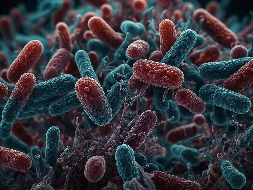Sometimes you can come across an amount or value that can get larger or smaller, very quickly over a certain period of time.
These situations can be described as exponential decay and growth.
For example a population of bacteria often grows at a very fast rate.

Exponential Decay = getting smaller quickly
Exponential Growth = getting larger quickly
Rate of Exponential Decay and Growth
The rate of exponential growth or decay can be established with the formula.
F(t) = a × ekt
– F(t) is the actual value or amount at a specific time t.
– a is the initial value or amount at the beginning.
– k is the rate of growth or decay.
( When k > 0, there is growth.
When k < 0, there is decay. )
– t is time.
– e is the exponential function.
Exponential Decay
Example
(1.1)

A cup of coffee cools down from an initial temperature of T0, to a new temperature of Tt, according to the formula.
a)
If the cup of coffee cooled from 90°C to 60°C in 8 minutes.
Calculate k to 3 significant figures.
Solution
T0 = 95, t = 8, T8 = 65
T8 = T0e-k8
60 = 90e-k8 ( ÷ 90 BOTH SIDES )
\bf{\frac{60}{90}} = e-k8 => \bf{\frac{2}{3}} = e-k8 , ( TAKE THE NATURAL LOGARITHM OF BOTH SIDES ) ln(ex) = x
ln(\bf{\frac{2}{3}}) = ln(e-k8) => ln(\bf{\frac{2}{3}}) = -k8
NOW
k = \bf{\frac{ln({\frac{2}{3}})}{{\text{-}}8}} = 0.0507
b)
How long did it take for the cup of coffee to cool to a temperature of 35°C?
Solution
T0 = 90, Tt = 35
35 = 90e–0.0507t ( ÷ 90 BOTH SIDES )
\bf{\frac{35}{90}} = e–0.0507t ( TAKE THE NATURAL LOGARITHM OF BOTH SIDES )
ln(\bf{\frac{35}{90}}) = ln(e–0.0507t) => ln(\bf{\frac{35}{90}}) = –0.0507t
NOW
t = \bf{\frac{ln({\frac{35}{90}})}{{\text{-}}0.0507}} = 18.6 minutes
Exponential Growth
Example
(2.1)
A population of bacteria grows according to the formula. B(t) = 68e1.5t
a)
How many bacteria are initially present?
Solution
Initially present at beginning, time t = 0,
B(0) = 68e1.5x0 = 40e0 = 68
68 bacteria are initially present.
b)
How many minutes does it take for the population of bacteria to double?
Solution
Population doubles when, B(t) = 136.
136 = 68e1.5t ( ÷ 68 BOTH SIDES )
2 = e1.5t ( TAKE THE NATURAL LOGARITHM OF BOTH SIDES )
ln(2) = ln(e1.5t) => ln(2) = 1.5t
NOW
t = \bf{\frac{ln(2)}{1.5}} = 18.6 minutes
To get the time in minutes multiply by 60.
0.462 × 60 = 27.72 minutes
Roughly 27 to 28 minutes for the amount of bacteria to double.